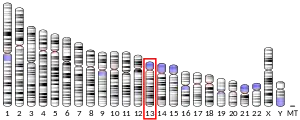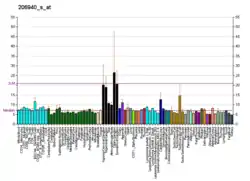POU4F1
POU domain, class 4, transcription factor 1 (POU4F1) also known as brain-specific homeobox/POU domain protein 3A (BRN3A), homeobox/POU domain protein RDC-1 or Oct-T1 is a protein that in humans is encoded by the POU4F1 gene.[5][6]
BRN3A (POU4F1) is a class IV POU domain-containing transcription factor highly expressed in the developing peripheral sensory nervous system (dorsal root ganglia, trigeminal ganglion, and hindbrain sensory ganglia), certain regions of the central nervous system, retinal neurons called ganglion cells, and in cells of the B- and T-lymphocytic lineages.[6][7]
Discovery
Brn3a was initially discovered in mice based on homology to the prototypal POU transcription factors Pit1 (Pituitary-specific positive transcription factor 1, Pou1f1), Oct1 (Pou2f1), and the Caenorhabditis elegans factor Unc86, and named Brn3.[8] When multiple members of the Brn3 gene class were discovered, it was renamed Brn3.0 and Brn3a by different groups of researchers.[7][9] Subsequently, the gene was systematically renamed Pou4f1 in mice and POU4F1 in humans. The protein product is still frequently referred to as Brn3a.
Function
In addition to sensory neurons, in rodents and birds (and presumably humans) Brn3a is expressed in multiple sites in the central nervous system, including the spinal cord, midbrain superior colliculus, red nucleus, nucleus ambiguus, inferior olivary nucleus, habenula, and retina.[10]
Mice with null mutations ("knockouts") in Brn3a die at birth, due to developmental defects in the nucleus ambiguus, which is essential for respiration.[11][12][13]
Brn3a is a transcription factor which acts in development by regulating downstream "target" genes. Microarrays have been used to determine many genes downstream of Brn3a in peripheral sensory neurons.[14][15]
In the sensory neurons Brn3a is co-expressed with the LIM domain transcription factor ISL1 or Islet1, and has many downstream targets in common with Isl1.[16] Pou4f1/Isl1 double mutant mice show strong epistatic effects in regulation of many downstream genes in the sensory neurons of double mutant mouse embryos.[17]
Although the homozygous Brn3a null mutation is lethal at birth in mice, Brn3a null heterozygotes have no known phenotype. i.e. the Brn3a null mutation is completely recessive. This can be explained by gene dosage compensation due to autoregulation,[18] in which expression of the remaining copy of the Pou4f1 gene is increased in heterozygotes, leading to near-normal expression of its downstream targets.[14] The combination of homozygote lethality and dosage compensation in heterozygotes may explain why POU4F1 mutations have not been identified in any human disease, whereas diseases are associated with several other members of the POU domain transcription factor class.
Interactions
POU4F1 has been shown to interact with Estrogen receptor alpha,[19] RIT2[20] and Ewing sarcoma breakpoint region 1.[21]
See also
References
- GRCh38: Ensembl release 89: ENSG00000152192 - Ensembl, May 2017
- GRCm38: Ensembl release 89: ENSMUSG00000048349 - Ensembl, May 2017
- "Human PubMed Reference:". National Center for Biotechnology Information, U.S. National Library of Medicine.
- "Mouse PubMed Reference:". National Center for Biotechnology Information, U.S. National Library of Medicine.
- Collum RG, Fisher PE, Datta M, Mellis S, Thiele C, Huebner K, Croce CM, Israel MA, Theil T, Moroy T (Sep 1992). "A novel POU homeodomain gene specifically expressed in cells of the developing mammalian nervous system". Nucleic Acids Research. 20 (18): 4919–25. doi:10.1093/nar/20.18.4919. PMC 334251. PMID 1357630.
- "Entrez Gene: POU4F1 POU domain, class 4, transcription factor 1".
- Gerrero MR, McEvilly RJ, Turner E, Lin CR, O'Connell S, Jenne KJ, Hobbs MV, Rosenfeld MG (Nov 1993). "Brn-3.0: a POU-domain protein expressed in the sensory, immune, and endocrine systems that functions on elements distinct from known octamer motifs". Proceedings of the National Academy of Sciences of the United States of America. 90 (22): 10841–5. doi:10.1073/pnas.90.22.10841. PMC 47874. PMID 8248179.
- He X, Treacy MN, Simmons DM, Ingraham HA, Swanson LW, Rosenfeld MG (Jul 1989). "Expression of a large family of POU-domain regulatory genes in mammalian brain development". Nature. 340 (6228): 35–41. doi:10.1038/340035a0. PMID 2739723.
- Xiang M, Zhou L, Macke JP, Yoshioka T, Hendry SH, Eddy RL, Shows TB, Nathans J (Jul 1995). "The Brn-3 family of POU-domain factors: primary structure, binding specificity, and expression in subsets of retinal ganglion cells and somatosensory neurons". The Journal of Neuroscience. 15 (7 Pt 1): 4762–85. doi:10.1523/JNEUROSCI.15-07-04762.1995. PMC 6577904. PMID 7623109.
- Fedtsova NG, Turner EE (Nov 1995). "Brn-3.0 expression identifies early post-mitotic CNS neurons and sensory neural precursors". Mechanisms of Development. 53 (3): 291–304. doi:10.1016/0925-4773(95)00435-1. PMID 8645597.
- McEvilly RJ, Erkman L, Luo L, Sawchenko PE, Ryan AF, Rosenfeld MG (Dec 1996). "Requirement for Brn-3.0 in differentiation and survival of sensory and motor neurons". Nature. 384 (6609): 574–7. doi:10.1038/384574a0. PMID 8955272.
- Xiang M, Gan L, Zhou L, Klein WH, Nathans J (Oct 1996). "Targeted deletion of the mouse POU domain gene Brn-3a causes selective loss of neurons in the brainstem and trigeminal ganglion, uncoordinated limb movement, and impaired suckling". Proceedings of the National Academy of Sciences of the United States of America. 93 (21): 11950–5. doi:10.1073/pnas.93.21.11950. PMC 38164. PMID 8876243.
- Eng SR, Gratwick K, Rhee JM, Fedtsova N, Gan L, Turner EE (Jan 2001). "Defects in sensory axon growth precede neuronal death in Brn3a-deficient mice". The Journal of Neuroscience. 21 (2): 541–9. doi:10.1523/JNEUROSCI.21-02-00541.2001. PMC 6763803. PMID 11160433.
- Eng SR, Lanier J, Fedtsova N, Turner EE (Aug 2004). "Coordinated regulation of gene expression by Brn3a in developing sensory ganglia". Development. 131 (16): 3859–70. doi:10.1242/dev.01260. PMID 15253936.
- Eng SR, Dykes IM, Lanier J, Fedtsova N, Turner EE (2007). "POU-domain factor Brn3a regulates both distinct and common programs of gene expression in the spinal and trigeminal sensory ganglia". Neural Development. 2 (1): 3. doi:10.1186/1749-8104-2-3. PMC 1796875. PMID 17239249.
- Sun Y, Dykes IM, Liang X, Eng SR, Evans SM, Turner EE (Nov 2008). "A central role for Islet1 in sensory neuron development linking sensory and spinal gene regulatory programs". Nature Neuroscience. 11 (11): 1283–93. doi:10.1038/nn.2209. PMC 2605652. PMID 18849985.
- Dykes IM, Tempest L, Lee SI, Turner EE (Jul 2011). "Brn3a and Islet1 act epistatically to regulate the gene expression program of sensory differentiation". The Journal of Neuroscience. 31 (27): 9789–99. doi:10.1523/JNEUROSCI.0901-11.2011. PMC 3143040. PMID 21734270.
- Trieu M, Ma A, Eng SR, Fedtsova N, Turner EE (Jan 2003). "Direct autoregulation and gene dosage compensation by POU-domain transcription factor Brn3a". Development. 130 (1): 111–21. doi:10.1242/dev.00194. PMID 12441296.
- Budhram-Mahadeo V, Parker M, Latchman DS (Feb 1998). "POU transcription factors Brn-3a and Brn-3b interact with the estrogen receptor and differentially regulate transcriptional activity via an estrogen response element". Molecular and Cellular Biology. 18 (2): 1029–41. doi:10.1128/mcb.18.2.1029. PMC 108815. PMID 9448000.
- Calissano M, Latchman DS (Aug 2003). "Functional interaction between the small GTP-binding protein Rin and the N-terminal of Brn-3a transcription factor". Oncogene. 22 (35): 5408–14. doi:10.1038/sj.onc.1206635. PMID 12934100.
- Thomas GR, Latchman DS (2002). "The pro-oncoprotein EWS (Ewing's Sarcoma protein) interacts with the Brn-3a POU transcription factor and inhibits its ability to activate transcription". Cancer Biology & Therapy. 1 (4): 428–32. doi:10.4161/cbt.1.4.23. PMID 12432261.
Further reading
- Eng SR, Lanier J, Fedtsova N, Turner EE (Aug 2004). "Coordinated regulation of gene expression by Brn3a in developing sensory ganglia". Development. 131 (16): 3859–70. doi:10.1242/dev.01260. PMID 15253936.
- Xiang M, Gan L, Zhou L, Klein WH, Nathans J (Oct 1996). "Targeted deletion of the mouse POU domain gene Brn-3a causes selective loss of neurons in the brainstem and trigeminal ganglion, uncoordinated limb movement, and impaired suckling". Proceedings of the National Academy of Sciences of the United States of America. 93 (21): 11950–5. doi:10.1073/pnas.93.21.11950. PMC 38164. PMID 8876243.
- Xiang M, Zhou L, Macke JP, Yoshioka T, Hendry SH, Eddy RL, Shows TB, Nathans J (Jul 1995). "The Brn-3 family of POU-domain factors: primary structure, binding specificity, and expression in subsets of retinal ganglion cells and somatosensory neurons". The Journal of Neuroscience. 15 (7 Pt 1): 4762–85. doi:10.1523/JNEUROSCI.15-07-04762.1995. PMID 7623109.
- Bhargava AK, Li Z, Weissman SM (Nov 1993). "Differential expression of four members of the POU family of proteins in activated and phorbol 12-myristate 13-acetate-treated Jurkat T cells". Proceedings of the National Academy of Sciences of the United States of America. 90 (21): 10260–4. doi:10.1073/pnas.90.21.10260. PMC 47754. PMID 8234287.
- Bonaldo MF, Lennon G, Soares MB (Sep 1996). "Normalization and subtraction: two approaches to facilitate gene discovery". Genome Research. 6 (9): 791–806. doi:10.1101/gr.6.9.791. PMID 8889548.
- Still IH, Cowell J (1996). "The Brn-3a transcription factor gene (POU4F1) maps close to the locus for the variant late infantile form of neuronal ceroid-lipofuscinosis". Cytogenetics and Cell Genetics. 74 (3): 225–6. doi:10.1159/000134422. PMID 8941380.
- Smith MD, Dawson SJ, Latchman DS (Jan 1997). "Inhibition of neuronal process outgrowth and neuronal specific gene activation by the Brn-3b transcription factor". The Journal of Biological Chemistry. 272 (2): 1382–8. doi:10.1074/jbc.272.2.1382. PMID 8995448.
- Budhram-Mahadeo V, Parker M, Latchman DS (Feb 1998). "POU transcription factors Brn-3a and Brn-3b interact with the estrogen receptor and differentially regulate transcriptional activity via an estrogen response element". Molecular and Cellular Biology. 18 (2): 1029–41. doi:10.1128/mcb.18.2.1029. PMC 108815. PMID 9448000.
- Frass B, Vassen L, Möröy T (Dec 2002). "Gene expression of the POU factor Brn-3a is regulated by two different promoters". Biochimica et Biophysica Acta (BBA) - Gene Structure and Expression. 1579 (2–3): 207–13. doi:10.1016/S0167-4781(02)00540-7. PMID 12427558.
- Thomas GR, Latchman DS (2003). "The pro-oncoprotein EWS (Ewing's Sarcoma protein) interacts with the Brn-3a POU transcription factor and inhibits its ability to activate transcription". Cancer Biology & Therapy. 1 (4): 428–32. doi:10.4161/cbt.1.4.23. PMID 12432261.
- Trieu M, Ma A, Eng SR, Fedtsova N, Turner EE (Jan 2003). "Direct autoregulation and gene dosage compensation by POU-domain transcription factor Brn3a". Development. 130 (1): 111–21. doi:10.1242/dev.00194. PMID 12441296.
- Ma L, Lei L, Eng SR, Turner E, Parada LF (Aug 2003). "Brn3a regulation of TrkA/NGF receptor expression in developing sensory neurons". Development. 130 (15): 3525–34. doi:10.1242/dev.00582. PMID 12810599.
- Sindos M, Ndisang D, Pisal N, Chow C, Singer A, Latchman DS (Aug 2003). "Measurement of Brn-3a levels in Pap smears provides a novel diagnostic marker for the detection of cervical neoplasia". Gynecologic Oncology. 90 (2): 366–71. doi:10.1016/S0090-8258(03)00261-0. PMID 12893201.
- Sindos M, Ndisang D, Pisal N, Chow C, Deery A, Singer A, Latchman D (2004). "Detection of cervical neoplasia using measurement of Brn-3a in cervical smears with persistent minor abnormality". International Journal of Gynecological Cancer. 13 (4): 515–7. doi:10.1046/j.1525-1438.2003.13303.x. PMID 12911730.
- Calissano M, Latchman DS (Aug 2003). "Functional interaction between the small GTP-binding protein Rin and the N-terminal of Brn-3a transcription factor". Oncogene. 22 (35): 5408–14. doi:10.1038/sj.onc.1206635. PMID 12934100.
- Gascoyne DM, Thomas GR, Latchman DS (May 2004). "The effects of Brn-3a on neuronal differentiation and apoptosis are differentially modulated by EWS and its oncogenic derivative EWS/Fli-1". Oncogene. 23 (21): 3830–40. doi:10.1038/sj.onc.1207497. PMID 15021903.
- Farooqui-Kabir SR, Budhram-Mahadeo V, Lewis H, Latchman DS, Marber MS, Heads RJ (Nov 2004). "Regulation of Hsp27 expression and cell survival by the POU transcription factor Brn3a". Cell Death and Differentiation. 11 (11): 1242–4. doi:10.1038/sj.cdd.4401478. PMID 15272315.
- Ndisang D, Faulkes DJ, Gascoyne D, Lee SA, Ripley BJ, Sindos M, Singer A, Budhram-Mahadeo V, Cason J, Latchman DS (Jan 2006). "Differential regulation of different human papilloma virus variants by the POU family transcription factor Brn-3a". Oncogene. 25 (1): 51–60. doi:10.1038/sj.onc.1209006. PMID 16247485.
- Diss JK, Faulkes DJ, Walker MM, Patel A, Foster CS, Budhram-Mahadeo V, Djamgoz MB, Latchman DS (2006). "Brn-3a neuronal transcription factor functional expression in human prostate cancer". Prostate Cancer and Prostatic Diseases. 9 (1): 83–91. doi:10.1038/sj.pcan.4500837. PMID 16276351.
External links
- POU4F1+protein,+human at the US National Library of Medicine Medical Subject Headings (MeSH)
This article incorporates text from the United States National Library of Medicine, which is in the public domain.






